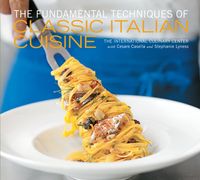Label
All
0
Clear all filters
Introduction to Cheese-Making
Formaggi
Appears in

The term cheese describes a solid food derived from the curdled milk or cream of ruminating animals (animals that chew their cud). Cheese starts with milk, most commonly from cows, goats, and sheep, but other animals, notably the bufala (water buffalo) of southern Italy, are milked for cheese. Each type of milk has a unique flavor that is, in part, identified with its fat content.
Cheese-making is an ancient science of preserving that developed organically out of necessity, over a period of thousands of years. It is the result of the historical need to process milk in such a way that this nutritional but highly perishable food could be made to last. As with all processes of preserving food, the more moisture that is removed, the less chance there is of spoilage, and the longer the food will last. Most cheese-making techniques, therefore, are simply different ways of eliminating moisture, starting with the most obvious process of draining, and progressing to more specialized techniques of cooking, and eventually aging. If the cheese is made to be eaten fresh, it is quickly made with relatively few processes; if it is being made to last, the processes are more complicated and time-consuming. How the cheese is handled throughout develops its specific identity. This is the art of cheese-making.
In this section
Advertisement
Advertisement
The licensor does not allow printing of this title


